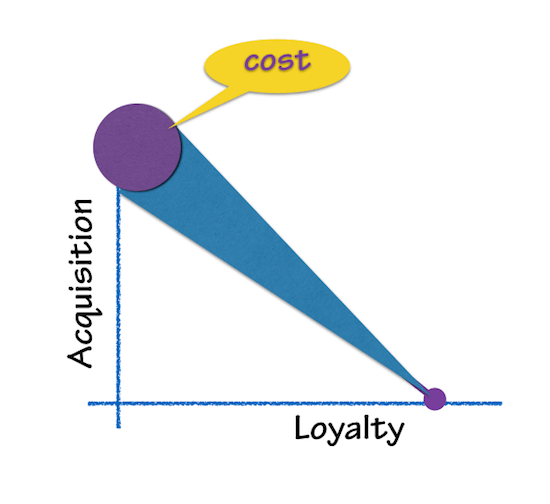Is it better to be a Hunter-Gatherer (acquisition mentality) or a Farmer-Nester (cultivating loyalty)? Of course, it is not about one or the other. Companies need to find a mix between acquisition and loyalty. No business can survive without first gaining new customers. Yet, what is the point of attracting new clients if one is not concerned with keeping them?

Moreover, it is common knowledge that loyal customers are worth more and cost less than new customers. There are statistics that are regularly trotted out saying that it costs 6-7x more to attract new customers than to keep existing ones. (N.B. The singular source for this “6-7x” information from Flowtown has been taken down, ironically, after it was acquired). All the same, there is not a single intelligent executive who would disagree with the principle of “keeping loyal customers.”
And yet…
As we know, somehow the idea of focusing on customer fidelity gets lost in translation (i.e. in execution). An article in the Daily Mail last week, entitled “The betrayal of loyal customers,” highlighted one of the underlying principles of (too many) publicly traded companies:
Milk (if not, screw) the long-term customers whenever you can”
The article writes, “[m]any [brands] only offer the better deals to new customers and leave their traditional, loyal customers in the shade.”
The hunter gatherer ensnares its customers

Many companies and marketing executives are programmed to find ways to acquire and ensnare customers, such that the (opportunity) cost of leaving is not “worth the bother” for the customer. These can include such strategies as long-term subscriptions, intentional opacity, complexity in or penalties for switching, walled-in eco-systems and, even, threats about not being able to get back in.
Why is loyalty so profitable?
All signs point to the fact that gaining customer loyalty is more profitable. The farmer-nester is intrinsically about nurturing and cultivating. A 1990 study by Bain & Company showed that a 5% increase in customer retention can increase a company’s profitability by 75%. (See HBR). It all seems rather intuitive and obvious, and yet there are plenty of misconceptions within this profitable loyalty notion. Like an article [now offline] by SPG Consulting that talks of the “Loyalty Effect,” there are two missing reasons for why loyal customers are more profitable than new customers:
- (a) user indulgence that can take the form of laziness, ignorance and/or excessive goodwill
- (b) express strategies by the company that focus on information inequity and purposeful opacity and/or deceit (think: small print).
Involuntary loyalty…
People in business will not and cannot admit any such things. However, the truth is – for having heard the conversation on the inside many a time – senior management often pride themselves for their intelligent “traps.” It’s the strategy of building a better mousetrap. Apple’s walled in eco-system continues (for now) to function because it delivers on delight and remains cool …at least more than the competition. {Tweet this!}
My respected friend, Brian Solis, wrote in a recent post entitled, “Companies Profit When Customers Suffer,” with appropriate cynicism how reducing the customer experience is good for profits. The model that Brian exposes is another one altogether: the more pain companies create for the basic service, the more customers will pay to avoid the problems (citing for airlines: long lines, additional baggage, priority boarding, leg room, inflight food & beverage…).
Based solely on empirical evidence, businesses struggle to keep attention on loyal customers in large part because of (a) the thrill of conquering a new customer and (b) the impatience with and/or intolerance of listening to “loyal” customers. Keeping long-term friends is a real talent. The skills and resources associated with keeping long-term relationships (farmer nester) fresh are very different from capturing new customers (hunter gatherer). It’s like the difference between puppy love and long-term profound bliss. Both are desirable. But, the latter requires a set of dynamic skills, not least of which are listening, humility and empathy, as well as learning how to evolve together.
Go get ’em

Telltale examples of companies that are acquisition-focused can be seen how their growth is organized and/or described. Acquisition of top line growth can come through four channels that are not mutually exclusive:
- New geographic territories
- New consumer segments/targets
- Competitive brand acquisitions
- New products (R&D)
It is easy to see how each of these can be costly. It would be, perhaps, a bit facile to describe the hunter-gatherer attitude as masculine and farmer-nester as feminine. However, I have to believe that there is a likely correlation between the number of men on the Executive Committee and the corporate tendency to promote the acquisition model versus the path of loyalty.* {If you agree, please tweet this!}
New Products (= “innovation”)
Creating new products is perhaps the least intuitive of the acquisition strategies on the list above. A company I know well was keen to inscribe in its strategy that “new” products were to represent between 8-15% of annual turnover. Innovation — the lifeblood of progress — is an honorable and noble value, held in particularly high regard by rationally programmed leaders (engineers, financiers or others). Obviously, new product innovation requires investment in R&D. Nothing wrong up to now. But, sometimes, new is just for “news” sake. Viewed from the loyal customer’s angle, some actually love the “old” product. When the old product is displaced with a new product that comes out with a higher price tag, the “loyal” customers come back to the trough and more or less begrudgingly shell out the premium, without a lesser associated cost of acquisition (advertising). Notwithstanding the evident benefits of innovation, there is also a veritable skill in knowing how to manage the base catalogue with one’s loyal customers.
Value in Customer Relationship Management
If the topic of CRM gets a lot of air time among consultants and conferences, there is typically a lesser emphasis on the notion of “management” as opposed to “customer” and “relationship.” Some companies segregate customer acquisition with bait and switch strategies and teams. The truth is that holding on to a “whiney” loyal customer can seem overtaxing for an organization. Listening and cultivating take time. And, senior executives can get awfully weary of hearing often-repeated complaints from “the same old voices.” It takes real skills to “manage” those loyal customers. {Tweet this!}
And yet…
It’s time for leadership to wake up to the perils of being constantly tuned up for hunting and to foster the skills and attitudes that come with being farmer-nester.
Your thoughts?
*Disclaimer: I admit that this is a grand generalization. We all have masculine and feminine traits and behaviors. Even the animal kingdom has their notable exceptions (female large cats do most of the hunting, the female ring-tailed lemur in Madagascar is dominant, etc). Yet, the rather aggressive nature of acquisition — that I associate with the hunter-gatherer — still feels on balance more like a masculine trait.










